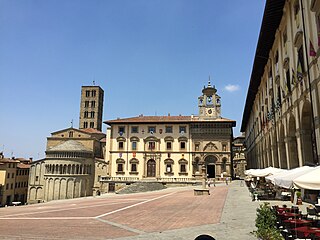
Arezzo is a city and comune in Italy and the capital of the province of the same name located in Tuscany. Arezzo is about 80 kilometres southeast of Florence at an elevation of 296 metres (971 ft) above sea level. As of 2022, the population was about 97,000.

Pistoia is a city and comune in the Italian region of Tuscany, the capital of a province of the same name, located about 30 kilometres (19 mi) north-west of Florence and is crossed by the Ombrone Pistoiese, a tributary of the River Arno. It is a typical Italian medieval city, and it attracts many tourists, especially in the summer. The city is famous throughout Europe for its plant nurseries.

Spoleto is an ancient city in the Italian province of Perugia in east-central Umbria on a foothill of the Apennines. It is 20 km (12 mi) south of Trevi, 29 km (18 mi) north of Terni, 63 km (39 mi) southeast of Perugia; 212 km (132 mi) southeast of Florence; and 126 km (78 mi) north of Rome.

The term Norman architecture is used to categorise styles of Romanesque architecture developed by the Normans in the various lands under their dominion or influence in the 11th and 12th centuries. In particular the term is traditionally used for English Romanesque architecture. The Normans introduced large numbers of castles and fortifications including Norman keeps, and at the same time monasteries, abbeys, churches and cathedrals, in a style characterised by the usual Romanesque rounded arches and especially massive proportions compared to other regional variations of the style.

Poggibonsi is a town in the province of Siena, Tuscany, Central Italy. It is located on the River Elsa and is the main centre of the Valdelsa Valley.
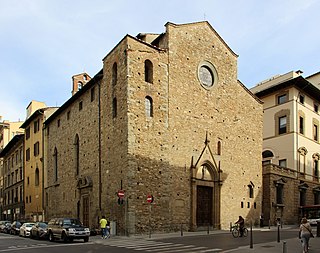
Santa Maria Maggiore di Firenze is a Romanesque and Gothic-style, Roman Catholic church in Florence, region of Tuscany, Italy. This is among the oldest extant churches in Florence.

Tavarnelle Val di Pesa is a former comune (municipality) and since 2019 a frazione of Barberino Tavarnelle in the Metropolitan City of Florence in the Italian region Tuscany. It is located about 25 kilometres south of Florence.

Stia is a frazione of the comune of Pratovecchio Stia in the Province of Arezzo in the Italian region Tuscany, located about 40 kilometres (25 mi) east of Florence and about 40 kilometres (25 mi) northwest of Arezzo. It was an independent commune until it was merged to Pratovecchio in 2014.

Casole d'Elsa [ˈkaːzole] is a comune (municipality) in the Province of Siena in the Italian region Tuscany, located about 50 kilometres (31 mi) southwest of Florence and about 25 kilometres (16 mi) west of Siena.
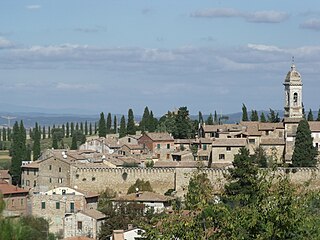
San Quirico d'Orcia is a comune (municipality) of about 2,500 inhabitants in the Province of Siena in the Italian region Tuscany, located about 80 kilometres (50 mi) southeast of Florence and about 35 kilometres (22 mi) southeast of Siena inside the Valdorcia landscape. It is named in honor of Saint Quiricus.
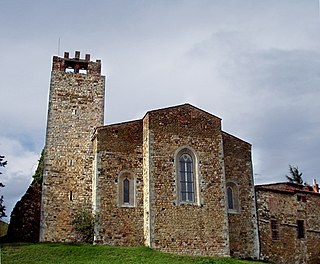
Campagnatico is a comune (municipality) in the Province of Grosseto in the Italian region Tuscany, located about 100 kilometres (62 mi) south of Florence and about 20 kilometres (12 mi) northeast of Grosseto in the valley of the Ombrone River.
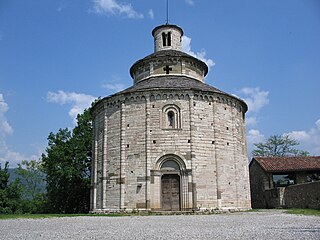
The Rotonda di San Tomè is a church in the comune (municipality) of Almenno San Bartolomeo, in the province of Bergamo, Lombardy, Northern Italy.

Italian Gothic architecture (also called temperate Gothic architecture, has characteristics that distinguish it considerably from those of the place of origin of Gothic architecture, France, and from other European countries in which this language has spread.

Portuguese Gothic architecture is the architectural style prevalent in Portugal in the Late Middle Ages. As in other parts of Europe, Gothic style slowly replaced Romanesque architecture in the period between the late 12th and the 13th century. Between the late 15th and early 16th century, Gothic was replaced by Renaissance architecture through an intermediate style called Manueline.

San Marco is a church in Milan, northern Italy.

San Salvatore is a former monastery in Brescia, Lombardy, northern Italy, now turned into a museum. The monastic complex is famous for the diversity of its architecture which includes Roman remains and significant pre-Romanesque, Romanesque and Renaissance buildings.
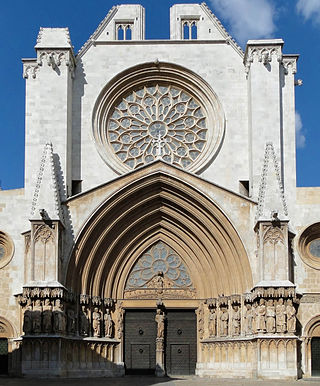
The Primatial Cathedral of Tarragona is a Roman Catholic church in Tarragona, Catalonia, Spain. The edifice is located in a site previously occupied by a Roman temple dating to the time of Tiberius, a Visigothic cathedral, and a Moorish mosque. It was declared a national monument in 1905.

The Basilica of San Giacomo Maggiore is an historic Roman Catholic church in Bologna, region of Emilia Romagna, Italy, serving a monastery of Augustinian friars. It was built starting in 1267 and houses, among the rest, the Bentivoglio Chapel, featuring numerous Renaissance artworks.

The Church of Santa Maria Maggiore, also known as the Sanctuary of the Spoliation, is a Catholic church in Assisi, Umbria, central Italy.






















